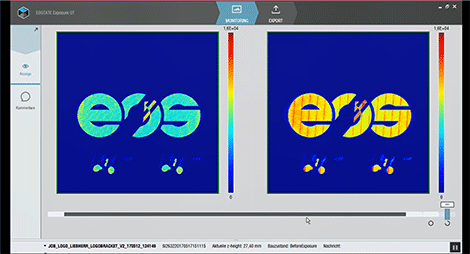
EOS’ new optical method of monitoring the 3D printing process means that parts deviating from the ‘normal’ can be quickly identified and marked
EOS is expanding its EOSTATE monitoring suite to include Exposure OT, its first system for optical tomography, which will provides real-time, camera-based monitoring of the additive, metal-based build process, based on the EOS M 290 system.
The solution fully maps each part throughout the build process, layer by layer, regardless of its geometry and size, helping customers meet stringent inspection requirements for each component, particularly in sectors such as aerospace.
With Optical Tomography (OT), the system deploys a high-resolution camera to monitor the exposure process, recording the complete building platform at high frequency in the near-infrared range throughout the entire print, thereby providing detailed data on the melting behavior of the material across the entire build space.
Based on the data captured, the melting behavior of steel, aluminum, titanium, and a variety of alloys involved in the additive build process can be analysed and monitored in great detail using special software.
If certain results deviate from a normal range, which can be individually defined by means of parameters, these areas are marked.
The growing volume of data makes it possible to determine the impact of these so-called indicators on the quality of the manufactured parts with ever greater precision.
EOS claim that Exposure OT is a self-learning system that becomes increasingly intelligent the more data it is fed: “The more precisely users become familiar with the specific parameters of their components, the better they can assess the quality and density of the parts they are manufacturing,” announced a spokesman.
“The ultimate aim is to recognise possible sources of defects during the building process and reject any defective parts.”
“Quality assurance is essential in large-scale manufacturing where reproducible component qualities are of prime significance,” explained EOS CTO Dr. Tobias Abeln. “Costs for quality assurance are significantly reduced as the monitoring process occurs early on at the build process stage. This has a positive impact on costs-per-part as well.”
The solution was developed in close collaboration with EOS strategic partner MTU Aero Engines, and two pilot customers, Liebherr and IPC, will also continue to use the system after the pilot phase and integrate it into their manufacturing processes.
Alexander Altmann, lead engineer for additive manufacturing/TRPI research and technology at Liebherr, said: “In the medium to long term, we will be looking to produce highly complex flight control system components using Additive Manufacturing.
“Here, real-time process monitoring as well is key to create an economically viable process chain. Widely used non-destructive examination processes such as CT are quite elaborate and expensive for manufacturing valve blocks.”






